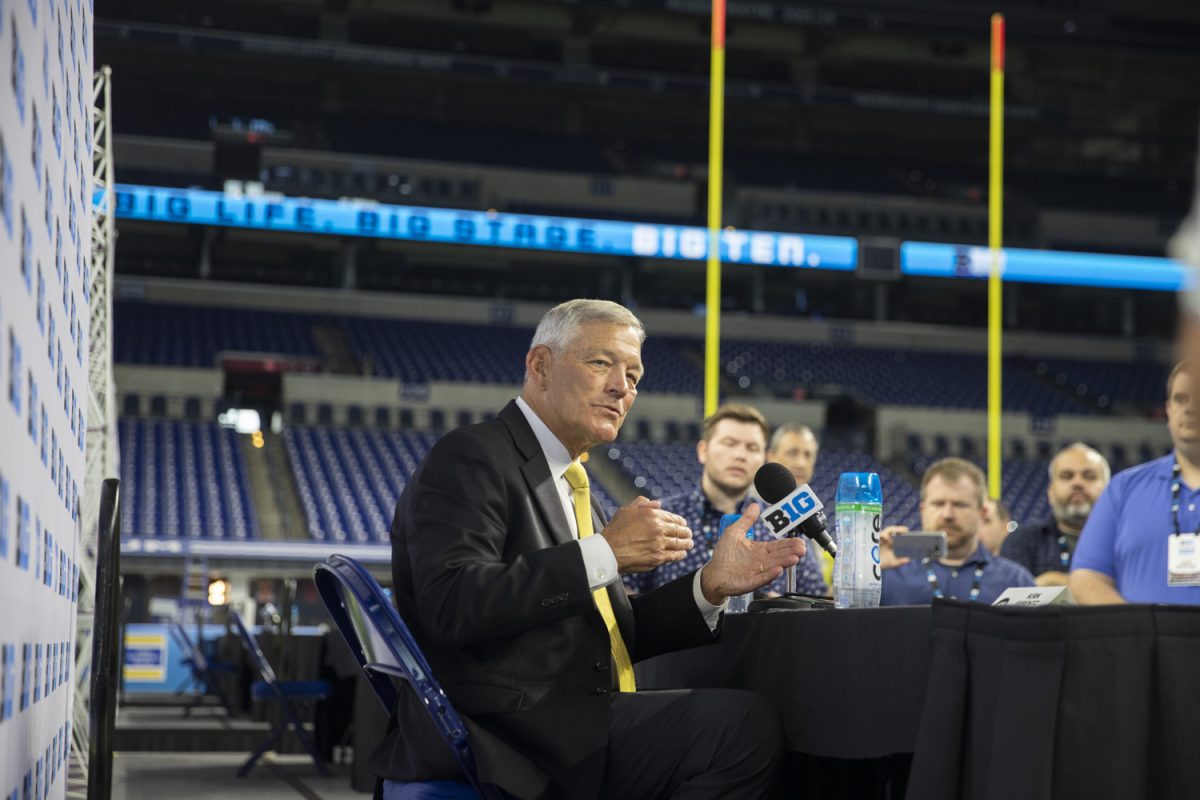The last time Kirk Ferentz played a video game was 25 years ago, so he says. He doesn’t remember which game, but he can’t forget the result.
“I got my ass kicked,” he said with a smile. “So I’m not really interested in that. I get a lot of those at other places.”
Such was certainly true back then, as Ferentz’s Hawkeyes collected just four wins during his first two years at the helm, so it’s safe to say the coach had more pressing matters on his mind.
The then-middle-aged Ferentz couldn’t waste time competing for the “taped-up bowling trophy” his kids used as a prize – he was eyeing to bring a national title back to Iowa City, and he couldn’t do that through a screen. But if the longest-tenured head coach in the FBS decides to pick up an Xbox or PlayStation controller anytime soon, he can hoist the championship trophy without leaving his office.
After a decade-long wait, everyone from the 69-year-old Ferentz to an 11-year-old boy can guide their favorite FBS football team to new heights in EA Sports “College Football 25,” which launched on July 19. The hit video game has taken over the free time of collegiate football players, who’ve utilized it to spark friendly rivalries and recreate their careers. Even if the game garners some critiques and frustration – and breaks a few remotes – the more than 10,000 student-athletes whose likenesses are featured couldn’t be more grateful.
Back when the game was released on a near-annual basis from 1993-2014, real-life players were frequently portrayed. but while their avatars had identical height, weight, and uniform numbers, their names were nowhere to be found. This issue of representation came to a head in 2014 when a federal court ruled that EA was violating antitrust law for not paying players for their virtual depictions. As a result, the NCAA and its conferences eliminated their trademark licensing from EA, and the game was shuttered.
When the NCAA opened the door for player compensation through name, image, and likeness in 2021, reviving the game became possible. Now, when players hop on the sticks, they can clearly see the names on the backs of their jerseys.
“I definitely think it does make a difference,” Rutgers linebacker Tyreem Powell said. “You get to see yourself with the name you represent, it’s great.”
Purdue head coach Ryan Walters remembers playing the video game back when he was a safety at Colorado from 2004-2008, admitting that it took up more spare time than it should’ve.
“Sometimes you were skipping class to play the video game, but don’t tell [my players] that,” he said with a smile. “I have to remind them all the time, ‘It’s not real. You didn’t really throw six touchdowns.’ But it’s fun to partake.”
The idea of watching yourself shine on the field, albeit in a virtual setting, is intoxicating for players like Maryland receiver Tai Felton, who recalled playing the game until the wee hours of the morning when it first came out. His go-to play – a jet-sweep to himself.
Fellow Big Ten wideout Pat Bryant of Illinois also centers the playbook around his avatar, whose abilities exceeded all expectations.
“I’m overpowered [in the game],” he said. “My EA version of me is crazy. I’ve seen some clips from my friends and nephews. I need to get some of his powers.”
Minnesota head coach P.J. Fleck even gave the game a shoutout during his introductory press conference at Big Ten Football Media Days, loudly proclaiming that Gopher starting right tackle Aireontae Ersery had the 24th-best player rating.
“He’s at 93 overall,” Fleck said of his 6-foot-6, 330-pound lineman. “But when you put him at tight end, he’s a 99, a hack.”
Yet no matter how talented one’s character is, success lies in the hands of whoever holds the controller. Bryant learned this lesson the hard way when he faced off against Northwestern receiver A.J. Henning at Big Ten Media Day. The result – three Bryant interceptions and an easy Wildcat victory.
Besides recreating rivalries and watching your team in action, EA College Football 25 offers players the chance to start their careers over again in its “Road to Glory” mode, where players start as recruits and build a legacy for themselves at whatever college they choose.
For Bryant, this meant he could assert himself as a five-star prospect with near-unlimited offers, but ultimately, the receiver chose to stick to his roots as a three-star recruit out of Atlantic Coast High School in Jacksonville, Florida.
Nevertheless, echoing back to Walters, the game isn’t quite on par with reality. Bryant pointed out how Illinois’ playbook was generic while UCLA defensive lineman Jay Toia said his hairstyle was a little outdated.
But these differences don’t make the game feel any less competitive. Michigan State running back Nathan Carter said his Spartan teammate, defensive back Dillon Tatum, broke his remote out of frustration.
With such an outpouring of emotions, as players attempt to relive days of old and fuel their competitive natures against teammates and rivals, Ferentz can only lament that he didn’t pay more attention all those years ago. He might not have led the Hawkeyes to a virtual title, but he could’ve walked away with something more valuable — cold hard cash.
“I wish I was an investor in that company, whoever came up with it,” Ferentz said with a smile.



